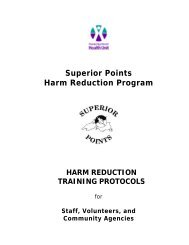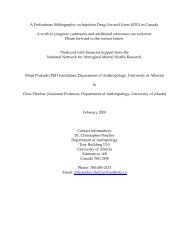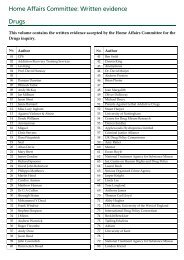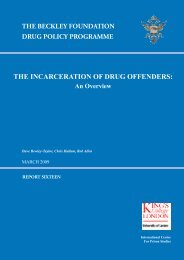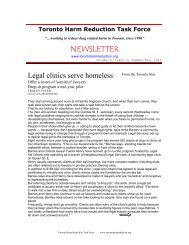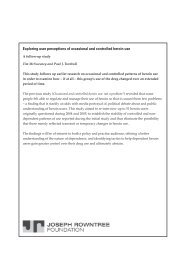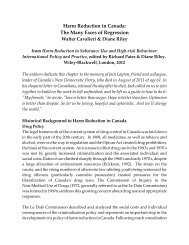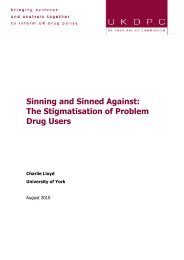and the building of the harm reduction-abstinence ... - ResearchGate
and the building of the harm reduction-abstinence ... - ResearchGate
and the building of the harm reduction-abstinence ... - ResearchGate
Create successful ePaper yourself
Turn your PDF publications into a flip-book with our unique Google optimized e-Paper software.
244<br />
S.H. Kellogg / Journal <strong>of</strong> Substance Abuse Treatment 25 (2003) 241–247<br />
The strength <strong>of</strong> <strong>the</strong> <strong>harm</strong> <strong>reduction</strong> approach is in its<br />
ability to connect <strong>and</strong> form relationships (Tatarsky, 2003;<br />
Westermeyer, 2003b). There is certainly something quite<br />
striking <strong>and</strong> quite noble about <strong>the</strong> outreach workers who go<br />
into potentially dangerous <strong>and</strong> unpleasant situations to make<br />
contact with societal ‘‘outcasts’’ (Springer, 2003). There is<br />
also something compelling about <strong>the</strong> creation <strong>of</strong> centers or<br />
subcultures for drug users in which <strong>the</strong>y receive acceptance<br />
<strong>and</strong> welcome (Mechanic, 1996), <strong>and</strong> where <strong>the</strong>y are greeted<br />
with <strong>the</strong> attitude <strong>of</strong>, ‘‘What can I do to help you’’ ra<strong>the</strong>r<br />
than that <strong>of</strong> ‘‘Here is what you must do’’ (Westermeyer,<br />
2003b, p. 1). The warmth <strong>of</strong> this approach may be a<br />
manifestation <strong>of</strong> what Dean James Parks Morton (1996)<br />
referred to as a spirituality <strong>of</strong> being ‘‘radically welcoming,’’<br />
<strong>and</strong> <strong>the</strong>se interventions could also serve as an entry point to<br />
a life-change process.<br />
Some <strong>harm</strong> <strong>reduction</strong> advocates might argue that gradualism<br />
is not necessary because <strong>harm</strong> <strong>reduction</strong> already<br />
includes <strong>abstinence</strong> as part <strong>of</strong> its continuum <strong>of</strong> care. This<br />
is not <strong>the</strong> case for two reasons. While some do believe that<br />
<strong>abstinence</strong> is a part <strong>of</strong> <strong>harm</strong> <strong>reduction</strong> (Marlatt et al., 2001),<br />
o<strong>the</strong>rs do not. Roche et al. (1997) have clearly made <strong>the</strong><br />
case that <strong>abstinence</strong>-oriented approaches should not be<br />
included under <strong>the</strong> <strong>harm</strong>-<strong>reduction</strong> umbrella.<br />
The mixed feelings about <strong>the</strong> incorporation <strong>of</strong> <strong>abstinence</strong><br />
in <strong>the</strong> model may also reflect some confusion <strong>and</strong> lack <strong>of</strong><br />
clarity about <strong>the</strong> ultimate goal <strong>of</strong> <strong>the</strong> <strong>harm</strong> <strong>reduction</strong><br />
enterprise. For example, Westermeyer (2003a, p. 1) argued<br />
that, ‘‘small <strong>reduction</strong>s are better than no <strong>reduction</strong>s ...[<strong>and</strong>]<br />
a ...small improvement can pave <strong>the</strong> path for fur<strong>the</strong>r<br />
<strong>reduction</strong>s <strong>of</strong> drug use.... eventually to <strong>the</strong> point <strong>of</strong> <strong>abstinence</strong>.’’<br />
Tatarsky (1998), while acknowledging <strong>the</strong> desirability<br />
<strong>of</strong> <strong>abstinence</strong> as an ideal, maintained that, ‘‘<strong>the</strong> ideal<br />
outcome <strong>of</strong> this approach is to support <strong>the</strong> user in reducing<br />
<strong>the</strong> <strong>harm</strong>fulness <strong>of</strong> substance use to <strong>the</strong> point where it has<br />
minimal negative impact on o<strong>the</strong>r areas <strong>of</strong> his or her life.<br />
Whe<strong>the</strong>r <strong>the</strong> outcome is moderation or <strong>abstinence</strong> depends<br />
on what is practically realistic for <strong>the</strong> client, <strong>and</strong> emerges<br />
from <strong>the</strong> treatment process (p. 12).’’ Single (1997, p. 8), in<br />
turn, goes a bit fur<strong>the</strong>r <strong>and</strong> writes that, ‘‘Harm <strong>reduction</strong> is<br />
simply neutral about <strong>the</strong> long-term goals <strong>of</strong> intervention.’’<br />
The Harm Reduction Coalition, in <strong>the</strong>ir list <strong>of</strong> principles,<br />
sees <strong>the</strong> ‘‘quality <strong>of</strong> individual <strong>and</strong> community life <strong>and</strong> wellbeing—not<br />
necessarily cessation <strong>of</strong> all drug use—as <strong>the</strong><br />
criteria for successful interventions <strong>and</strong> policies’’ (Harm<br />
Reduction Coalition, 2003, p. 1).<br />
This neutrality about <strong>the</strong> ultimate goal <strong>of</strong> treatment also<br />
separates <strong>harm</strong> <strong>reduction</strong> from gradualism. The problem with<br />
neutrality is that it runs <strong>the</strong> risk <strong>of</strong> encouraging stagnation, <strong>of</strong><br />
not fostering a kind <strong>of</strong> <strong>the</strong>rapeutic or healing momentum.<br />
This opposition to making <strong>abstinence</strong> <strong>the</strong> ultimate, if not<br />
<strong>the</strong> immediate, goal may well be connected to some <strong>of</strong> <strong>the</strong><br />
social origins <strong>of</strong> <strong>the</strong> <strong>harm</strong> <strong>reduction</strong> approach, <strong>and</strong> it may be<br />
consistent with what Pearson (1991) called <strong>the</strong> ‘‘Orphan’’<br />
archetype. In this vision, addicted people are seen as an<br />
oppressed <strong>and</strong> disenfranchised group. Not infrequently, <strong>the</strong>y<br />
have been <strong>the</strong> victims <strong>of</strong> emotional, physical, <strong>and</strong>/or sexual<br />
abuse (Springer, 2003). The result is a network or community<br />
<strong>of</strong> wounded people who seek to care <strong>and</strong> nurture each<br />
o<strong>the</strong>r, while sharing contempt for <strong>the</strong> forces <strong>and</strong> symbols <strong>of</strong><br />
authority. In this light, traditional drug-treatment programs<br />
are certainly seen as authoritarian <strong>and</strong> punitive.<br />
4. Building <strong>the</strong> continuum<br />
Perhaps one way to underst<strong>and</strong> how a gradualist continuum<br />
could exist would be to see it in terms <strong>of</strong> a<br />
developmental model involving child <strong>and</strong> parental images.<br />
The high level <strong>of</strong> acceptance <strong>of</strong> addicted people found in<br />
<strong>harm</strong>-<strong>reduction</strong> settings is likely to be experienced as a<br />
form <strong>of</strong> unconditional positive regard, <strong>of</strong> caring without<br />
dem<strong>and</strong>s. It is well reflected in <strong>the</strong> <strong>harm</strong> <strong>reduction</strong> emphasis<br />
on meeting <strong>the</strong> patient ‘‘where <strong>the</strong>y’re at’’ (Denning, 2001;<br />
Denning & Little, 2001, p. 1; Harm Reduction Coalition,<br />
2003). This open nurturing may do a great deal to help<br />
build relationships <strong>and</strong> get <strong>the</strong>se addicted persons reconnected<br />
again. The <strong>harm</strong> <strong>reduction</strong> site becomes something<br />
<strong>of</strong> a ‘‘holding environment’’ (Greenberg & Mitchell,<br />
1983; Winnicott, 1965). This may well work because, in<br />
my opinion, <strong>the</strong>re is, among many <strong>of</strong> <strong>the</strong>se patients, a deep<br />
longing for good, nurturing, affirming authority—perhaps<br />
especially for good fa<strong>the</strong>rs (Bly, 1992; Thompson, 1991).<br />
However, <strong>the</strong> good parent does not simply love unconditionally.<br />
And while it may be important to meet <strong>the</strong> patient<br />
where he or she is, it may not be such a good idea to leave<br />
him or her <strong>the</strong>re (see also Gelormino, 2002). As Goe<strong>the</strong><br />
wrote, <strong>and</strong> Viktor Frankl (1985) affirmed, ‘‘If I accept you<br />
as you are, I will make you worse; However, if I treat you<br />
as though you are what you are capable <strong>of</strong> becoming, I help<br />
you become that’’ (quoted in Mayo, 1996, p. 240). The<br />
good parent not only nurtures, but also affirms <strong>the</strong> possibility<br />
within <strong>the</strong> child. Within <strong>the</strong> context <strong>of</strong> <strong>the</strong> <strong>harm</strong><br />
<strong>reduction</strong> classification schemes, this affirmation means<br />
working to keep <strong>the</strong>m alive, to protect <strong>the</strong>ir health, <strong>and</strong> to<br />
help <strong>the</strong>m to heal <strong>and</strong> get better. The parent that does not<br />
take action to help a child who is in pain or in danger may<br />
not be felt to be a good parent, <strong>and</strong>, since <strong>the</strong> patients<br />
<strong>the</strong>mselves, for <strong>the</strong> most part, do not think that <strong>the</strong> use <strong>of</strong><br />
drugs is a good or life-affirming activity, <strong>the</strong>re is a question<br />
as to what kind <strong>of</strong> message <strong>the</strong> psycho<strong>the</strong>rapist is giving if<br />
he or she does not ultimately (even if not immediately)<br />
direct <strong>the</strong>m toward <strong>abstinence</strong>.<br />
From this perspective, <strong>the</strong> eventual emphasis on <strong>abstinence</strong>,<br />
within a context <strong>of</strong> seeing both <strong>the</strong> woundedness <strong>and</strong><br />
<strong>the</strong> potential within <strong>the</strong>se individuals, also becomes a form<br />
<strong>of</strong> nurturing. The next step, <strong>the</strong>n, would be for people to<br />
make a successful transition to an empowering, recoveryoriented<br />
treatment, <strong>and</strong>, hopefully, to a healthy, productive,<br />
<strong>and</strong> drug-free life. The comprehensive needle exchange<br />
program described by Majoor <strong>and</strong> Rivera (2003) appears<br />
to embody many <strong>of</strong> <strong>the</strong>se dynamics.




